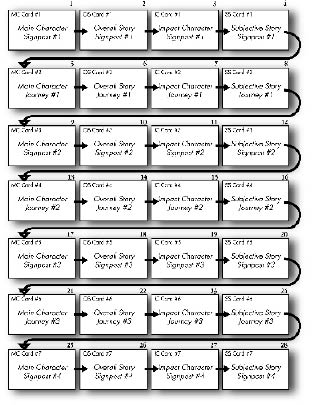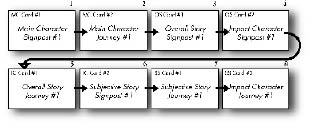Space and Time Together Again
By now, you should be familiar with the idea that part of a story's structure is made up of Static Story Points and part consists of Progressive Story Points. It is here in Storyweaving that we must find a way to blend the two together so all aspects of our story can unfold in concert.
In the Plot section of Storyencoding, we learned how the four structural and three dynamic acts of each throughline work as four signposts that defined three journeys. Although there are many ways we might weave all of this into a story, there is one straightforward method that is useful to illustrate the basic concepts.
First, think of each signpost and each journey not as an act, but as a Storyweaving scene. From this perspective, we can see there will be twenty-eight scenes in our story (four signposts and three journeys in each of four throughlines). If we write the Type of each signpost on a card and then write the Types that describe the beginning and ending of each journey on a card, we end up with twenty-eight cards. Each card represents a Storyweaving scene. (It is a good idea to put all the signposts and journeys from each throughline on a different color card to tell them apart easily.)
Now, we have in front of us twenty-eight scenes. Each one has a job to do, from a structural point of view. Each one must express to an audience the story point it represents. This is the process of encoding the signposts and journeys as we did in the Plot section of Storyencoding. We might write that encoding right on each card so we can tell at a glance what is going to be happening in that scene.
It is at this point we can begin to Storyweave. What we want to decide is the order in which those twenty-eight scenes will be played out for our audience. A good rule of thumb for a straightforward story is to keep the scenes in each throughline in order. So, Signpost 1 will be followed by Journey 1 which is in turn followed by Signpost 2 and Journey 2, and so on.
Now we run into a bit of a sticky wicket. Since all four throughlines are happening simultaneously from a structural point of view, all four Signposts 1 from all four throughlines occur at the same time! Of course, this might be difficult unless we were making a movie and used a four-way split screen. Still, some of our most sophisticated authors find ways to use a single event to represent more than one dramatic point at a time. This technique requires experience and inspiration.
A much more practical approach for those using Dramatica for the first time is to put one of the Signposts 1 first, then another, a third, and finally the last. Which of the four Signposts 1 goes first is up to our personal tastes, no limitations whatever. Although this is not as complex as describing all four throughlines at once, it is a much easier pattern to weave and has the added advantage of providing better clarity of communication to our audience.
Next, we will want to Storyweave all four Journeys 1. We might decide to move through them in the same order as the Signposts or to choose a different sequence. Again, that has no structural impact at all, and is up to our creative whims.
Just because we have absolute freedom, however, does not mean our decision has no affect on our audience. In fact, the order in which each scene crops up determines which information is a first impression and which is a modifier. It is a fact of human psychology that first impressions usually carry more weight than anything that follows. It takes much undoing to change that first impact. This is why it is usually better to introduce the Main Character's Signpost 1 before the Impact Character Signpost 1. Otherwise, the audience will latch onto the Impact Character and won't switch loyalty until farther into the story. Clearly, if our weaving has brought the audience to think the Impact Character is the Main Character, we have failed to suggest the real structure and meaning of our story. So, just because we have freedom here doesn't mean we are not accountable.
Using these techniques, we could order all the Signposts and Journeys for all four throughlines until we set up a Storyweaving sequence for all twenty-eight scenes.

Storyweaving the 28 simple scenes with minimal weaving
Before we move on to the next step of this introduction to building Storyweaving scenes, we can loosen up our constraints even a bit further. We don't have to present all four Signposts and then all four Journeys. Together, each Signpost and Journey pair moves a throughline from where it starts right up to the edge of the next act break. Each pair feels to an audience as if they belong in the first act for that throughline. Therefore, as long as the Signposts precede their matching Journeys, the order of exposition can stick with one throughline for both Signpost and Journey or jump from a Signpost to another throughline before returning to the matching Journey.
Taking this more liberal approach, we might begin with Main Character Signpost 1 and Journey 1 (as illustrated below), then show Overall Story Signpost 1, then Impact Character Signpost 1, Overall Story Journey 1, Subjective Story Signpost 1 and Journey 1, and end with Impact Character Journey 1. In this manner, the Signposts and Journeys in each throughline stay in order, but we have much more latitude in blending the four throughlines together.
This still may be too chunky for our taste. If we want, we can break Signposts and Journeys into multiple parts. Each part explores only a portion of the Signpost or Journey. In this way we can weave the throughlines together more tightly than using whole Signposts and Journeys. When you subdivide Signposts and Journeys into smaller pieces, you allow for greater freedom in your storyweaving.
In practice, subdividing Signposts and Journeys into multiple pieces is a more commonly used approach than leaving entire Signposts and Journeys intact.

